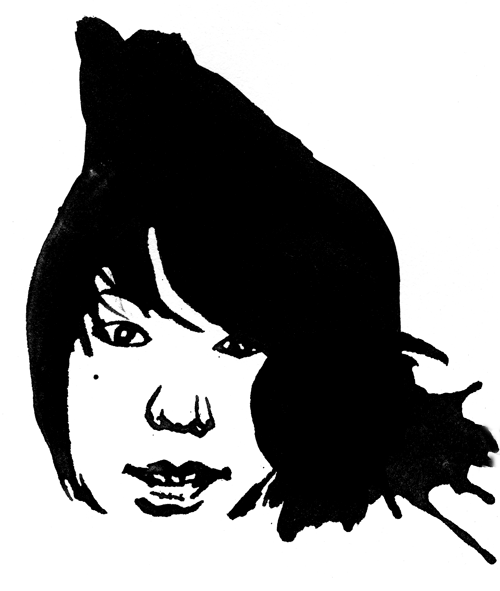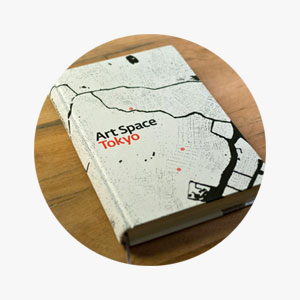
MAHIRO, director
In addition to his work as director of Gallery éf, Mahiro has been director of Jibo Salon, an art space in Shanghai, since 2006.
How did you come to use this warehouse as a gallery?
MThe older generation in my family had bought the entire property, and there was a metal wholesaling company here. The café area used to be the garage and a metal workshop, and the kura storehouse that just happened to be attached. When our grandfather passed away, the remaining family members decided that it needed to be sold. In preparation we cleaned out the building, including the storage area at the back. It looked like an ordinary room, but when we pulled the walls down, the actual building structure appeared along with writing that indicated that it had been built in 1868, the last year of the Edo Period, or the first year of the Meiji Restoration. At that point we still wanted to sell, but we came up with the idea of telling the outside world what once existed in that location before the final sale.
But somehow you didn’t end up selling ...
MNo, in the end we didn’t. At art school I had met a student whose illustrations I really liked, and I thought it would be interesting to exhibit her works in a rundown building like the one we had — just once. But this was over ten years ago, after the economic bubble had burst, so we couldn’t find anyone interested in purchasing the property. And although we still wanted to sell, it also dawned on us that since the kura is old, it would probably be destroyed and replaced with a brand new apartment building soon after, and that seemed less than ideal. So we decided to do whatever was within our power to make this place survive. We didn’t set out to open a gallery as such, but gradually that’s what we ended up doing.
How did you manage to restore the space when there was so little money around?
MAt that time we happened to meet a lacquer artist named Tsugio Nabeshima who volunteered to help renovate the building. At first there were three of us doing demolition work and other tasks, but since he was very well connected with artist friends, every day someone new would be doing some work in a part of the space. People just gathered here like that, and in the end over a period of six months we accumulated two hundred days’ worth of labor from them. We didn’t have any money, but we thought the least we could do was to feed everyone. There were even some people who just came for the snacks, but you couldn’t even tell who they were at that point! One time I asked Nabeshima-san why he was willing to do all this for free, since that kind of thing is usually unheard of. He said, “It’s really difficult to ‘play seriously’ — not to just go out on the town, but to really put all your effort into playing. For someone to give you free reign to do any work you want over an entire building is truly rare. If someone is letting you play like that, why would you ask for money?” It made sense to me. In terms of time, at first we thought we could renovate the building in three months, but that became four, and five, and in the end it took a year with six months of that spent on construction.
At the renovation stage, did you have an idea of what the completed space would look like?
MI think of buildings in terms of the people involved with them, rather than in terms of the space itself. Even if you have a good space, if there are no people, then you’re left with nothing, so I was constantly thinking about how to create a space that would attract people. This building has a 140-year history, so I wanted to represent that physically in the building through a series of ‘stages.’ The entrance area is the present, and the innermost part represents the building’s earliest history.
Since the work was done by artists, there was no set idea of what the final space should look like. The end result was the balanced outcome of not one person leading the process, but of everyone speaking and communicating in imagery and coming to an agreement. We had professional carpenters working in the café area, but carpenters are used to working to a client’s brief. We, on the other hand, were telling them to do whatever they wanted. Initially they were frustrated and told us they couldn’t work like that, but we continued to tell them to just do whatever they wanted. In the end they started playing around too.
What do you look for in artists before offering them exhibitions here?
MWe don’t emphasize exhibitions of famous, top-selling artists. One reason is because we want to remember all the unknown young artists who volunteered to make this place what it is. The volunteers made us realize that there is a lot that can be done without money; they showed us that level of imagination, and so we want to work with artists who offer us the possibility of that kind of creativity.
The other has to do with our space. Typically solo exhibitions are held in gallery spaces where an artist gathers his or her friends to view their work. People call them exhibitions but all too often they’re actually exhibitionist activities that are all about creating a stage for yourself and saying, “Look at me.” We want the artists who exhibit here to create a stage for the works, not for themselves. Also, we want them not to depend on the strengths of the space. We don’t want them to use the space simply to make up for something that may be lacking in their works. These are our two points. It’s not that we ask them to put on exhibitions that fit these two criteria — we just don’t accept artists who don’t share these ideas.
he white cube style of gallery is everywhere in Tokyo; if anything it’s an international standard. What are your thoughts on it?
MI’m envious, because it’s easier to work in those kinds of spaces. I don’t think it’s uninteresting. It’s just that our way of doing things is different, because the space that we’re working with is different. If we had a white space, we would be working in different ways also. We just coexist differently with the space.
What are the practical issues behind designing an exhibition in this space?
MYou can’t hammer nails into the walls. In a white cube gallery you can, but this building has earthen walls so you can’t make any holes. It’s at this point that some artists give up and others start thinking about how to realize their creative styles. We inform our artists of what can and cannot be done in this space beforehand, but we don’t just want to dwell on what cannot be done. If an artist has something he or she wants to express, it can be realized if the artist thinks about the execution, but you can’t shortchange that step. If you try something and it doesn’t work, that’s one thing, but you can’t give up what you want to do without even trying.
Another difficulty is that you can’t position the light rails to surround the pieces, so lighting needs to be well thought out. We spend about six months to a year communicating with the artists about how they might want to use the space and ask them to keep on coming up with ideas. This back-and-forth is the only way to realize an exhibition here. Of course we’re busy too, so we can’t accept an artist one week before an exhibition. It’s impossible to use this space unless you’re willing to think creatively and use your imagination.
Do you have any views on the Tokyo art scene as a whole?
MI spend two-thirds of the year in Shanghai, so I’m not very familiar with Tokyo’s art scene. I’m conscious of how I might be influenced by knowing too much. I want to work from a blank slate, so I don’t look around Tokyo very much. It’s the same way with clothes: you can get to know different styles from looking at magazines, but I don’t want to do that. So I look around at as little as possible in order to maintain my originality. I have no idea whether I’m ahead of the times, or whether what I’m doing is in fashion or not; I don’t know if what I’m doing is ‘correct’ or ‘incorrect,’ but that’s my style.
You’ve opened a sister gallery in Shanghai too, called Jibo Salon, right?
MYes, we’ve been in Shanghai for about eight years, and we’ve had a space since a little over a year ago. Originally I went to Shanghai to learn about the roots of our culture and study kanji characters as the point where communication originated. My initial purpose was not to open a gallery. One day we started talking about wanting a place to hold cultural events, and we decided to create one, but not a gallery. We wanted a multipurpose space that could be used as an office, an exhibition space, a yoga hall, whatever you wanted. China isn’t organized like Japan — people will just put their things down and eat in galleries — so we decided to use that to our advantage.
What are the points in common between the way the two spaces function?
MI think they both function as places where people can gather and communicate. Nothing will happen if people don’t gather, no matter how great your location and physical space.
We’d like to continue using the space as a place to express Jibo ideas1 by holding exhibitions and events relating to kanji characters and communication, and collaborating with overseas artists.
What do you think Gallery éf ’s role or function is in the Tokyo art scene?
MI think in terms of Asakusa rather than Tokyo, but I think art carries with it the image of being hard to approach. People will say, “It’s hard for me to even make a living — I couldn’t possibly think about buying art,” especially because unlike Aoyama or Ginza, this neighborhood has never been known as a place for art. I want to tell them that it’s not so. We all live our lives based on imagery, and yet people project an unapproachable image onto the expressive arts. If there is a role that we can play as Gallery éf, it’s to give art a more approachable image in Asakusa, so that more people will know that art is something that can be enjoyed casually, without the fear of being judged.
Are there disadvantages to being located in Asakusa?
MMost of the people who come to Asakusa are here for sightseeing; they’re not in the frame of mind for buying art. It’s a weakness of this space also, but our exhibitions tend to look like installations, and it’s sometimes unclear to viewers whether the works can be purchased or not. If this were solely a gallery, we might not have survived, so I’m glad that we had the chance to run a café and bar here.
The positive point is that we can run a casual environment. For example this luggage that’s been left lying around on the floor would definitely not be allowed in a gallery in Aoyama. Here, foreigners complain, Japanese people cry, people of all ages come in, and all kinds of barriers are broken down. People who are not so interested in art have the opportunity to meet artists and become inclined to take a look. This process in which people gradually take interest is very visible, partly due to the tight shitamachi2 old town connections. I’ve seen middle-aged men step into an avant-garde exhibition here and go home saying they enjoyed it. This probably doesn’t happen in Aoyama.
What do you consider to be a successful exhibition?
MAs a phenomenon, having a lot of visitors. But that alone is not enough. At our opening parties, both the usual crowd and those who haven’t that much interest in art will have some kind of contact with an artist, and that will become the trigger for that person to become conscious of something he or she was totally unaware of until then. Viewer numbers alone are insufficient: it’s just numbers. Communication needs to take place. There are moments when I can actually feel the change in someone. For example, when I hear a lot of opinions flying about, whether they are good or bad, it means that those people were moved. I think that being able to feel that change or movement is what makes an exhibition successful.
Gallery éf is celebrating its ten-year anniversary. Where do you see things going from here?
MThese ten years turned out to be really fun for us, but in going forward we would like to be more conscious of how we can share this joy and fun with everyone. What awaits you may be different from the future you envision, but it could be even better. We have learned that there is no money to be made this way. If we tell this to the younger generation though, they only have two options: to feel content producing art that doesn’t make money, or not to produce art at all.
As I’ve been saying, if you are imaginative and don’t bend your will, there are times when the unexpected happens. You need to hang on to what you want to do and meet people who will understand and support your ideas, and then perhaps they will allow you to realize them.
Also, since artists tend to be as stubborn as we are, I want to become better at exchanging different opinions. At times we have had such intense confrontations that it’s as if we’re denying each other’s very existence. Still, for the most part we don’t clash but become closer. At out gallery the communication we have with artists takes place at an intimate level, and I think fundamentally that is what makes our work successful.
Noted
- Ji means ‘character’ (as in kanji character) and bo can mean ‘workshop’ or ’monk.’ Together, the word represents the gallery’s philosophy of bringing people together in one space for creative interaction.↩
- Shitamachi can be translated as ‘downtown’ but in the Tokyo context it refers to all districts that that were lower than Edo castle. Like Asakusa, many of these areas retain an old world feel to them. There is even a Shitamachi Museum.↩

